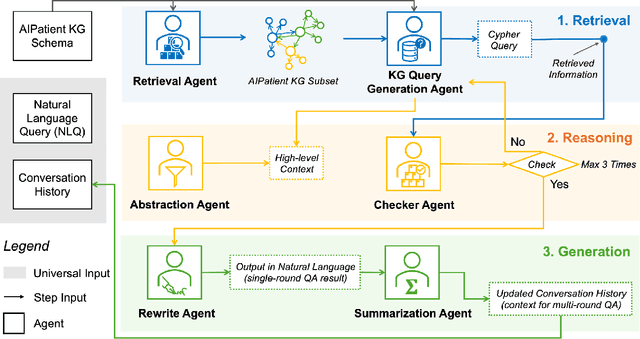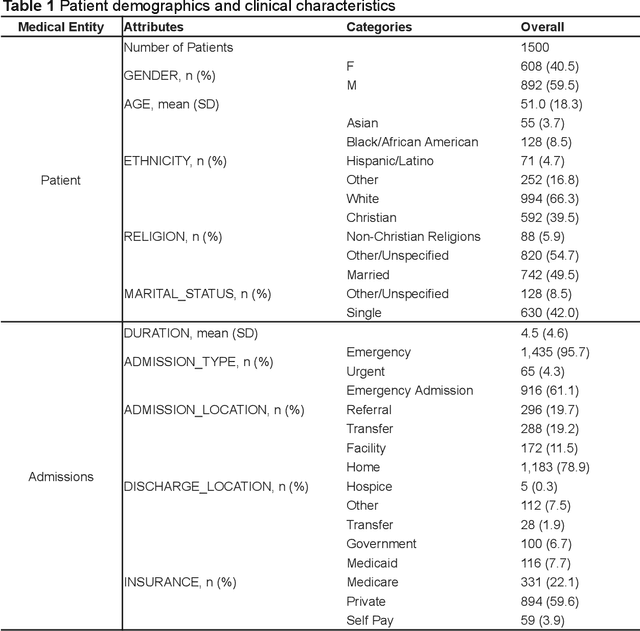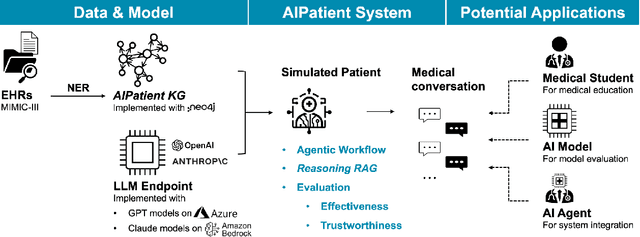Lin Lu
Comparative Analysis of Pre-trained Deep Learning Models and DINOv2 for Cushing's Syndrome Diagnosis in Facial Analysis
Jan 21, 2025



Abstract:Cushing's syndrome is a condition caused by excessive glucocorticoid secretion from the adrenal cortex, often manifesting with moon facies and plethora, making facial data crucial for diagnosis. Previous studies have used pre-trained convolutional neural networks (CNNs) for diagnosing Cushing's syndrome using frontal facial images. However, CNNs are better at capturing local features, while Cushing's syndrome often presents with global facial features. Transformer-based models like ViT and SWIN, which utilize self-attention mechanisms, can better capture long-range dependencies and global features. Recently, DINOv2, a foundation model based on visual Transformers, has gained interest. This study compares the performance of various pre-trained models, including CNNs, Transformer-based models, and DINOv2, in diagnosing Cushing's syndrome. We also analyze gender bias and the impact of freezing mechanisms on DINOv2. Our results show that Transformer-based models and DINOv2 outperformed CNNs, with ViT achieving the highest F1 score of 85.74%. Both the pre-trained model and DINOv2 had higher accuracy for female samples. DINOv2 also showed improved performance when freezing parameters. In conclusion, Transformer-based models and DINOv2 are effective for Cushing's syndrome classification.
AIPatient: Simulating Patients with EHRs and LLM Powered Agentic Workflow
Sep 27, 2024



Abstract:Simulated patient systems play a crucial role in modern medical education and research, providing safe, integrative learning environments and enabling clinical decision-making simulations. Large Language Models (LLM) could advance simulated patient systems by replicating medical conditions and patient-doctor interactions with high fidelity and low cost. However, ensuring the effectiveness and trustworthiness of these systems remains a challenge, as they require a large, diverse, and precise patient knowledgebase, along with a robust and stable knowledge diffusion to users. Here, we developed AIPatient, an advanced simulated patient system with AIPatient Knowledge Graph (AIPatient KG) as the input and the Reasoning Retrieval-Augmented Generation (Reasoning RAG) agentic workflow as the generation backbone. AIPatient KG samples data from Electronic Health Records (EHRs) in the Medical Information Mart for Intensive Care (MIMIC)-III database, producing a clinically diverse and relevant cohort of 1,495 patients with high knowledgebase validity (F1 0.89). Reasoning RAG leverages six LLM powered agents spanning tasks including retrieval, KG query generation, abstraction, checker, rewrite, and summarization. This agentic framework reaches an overall accuracy of 94.15% in EHR-based medical Question Answering (QA), outperforming benchmarks that use either no agent or only partial agent integration. Our system also presents high readability (median Flesch Reading Ease 77.23; median Flesch Kincaid Grade 5.6), robustness (ANOVA F-value 0.6126, p<0.1), and stability (ANOVA F-value 0.782, p<0.1). The promising performance of the AIPatient system highlights its potential to support a wide range of applications, including medical education, model evaluation, and system integration.
Conditional Testing based on Localized Conformal p-values
Sep 25, 2024Abstract:In this paper, we address conditional testing problems through the conformal inference framework. We define the localized conformal p-values by inverting prediction intervals and prove their theoretical properties. These defined p-values are then applied to several conditional testing problems to illustrate their practicality. Firstly, we propose a conditional outlier detection procedure to test for outliers in the conditional distribution with finite-sample false discovery rate (FDR) control. We also introduce a novel conditional label screening problem with the goal of screening multivariate response variables and propose a screening procedure to control the family-wise error rate (FWER). Finally, we consider the two-sample conditional distribution test and define a weighted U-statistic through the aggregation of localized p-values. Numerical simulations and real-data examples validate the superior performance of our proposed strategies.
Methodology and Real-World Applications of Dynamic Uncertain Causality Graph for Clinical Diagnosis with Explainability and Invariance
Jun 09, 2024Abstract:AI-aided clinical diagnosis is desired in medical care. Existing deep learning models lack explainability and mainly focus on image analysis. The recently developed Dynamic Uncertain Causality Graph (DUCG) approach is causality-driven, explainable, and invariant across different application scenarios, without problems of data collection, labeling, fitting, privacy, bias, generalization, high cost and high energy consumption. Through close collaboration between clinical experts and DUCG technicians, 46 DUCG models covering 54 chief complaints were constructed. Over 1,000 diseases can be diagnosed without triage. Before being applied in real-world, the 46 DUCG models were retrospectively verified by third-party hospitals. The verified diagnostic precisions were no less than 95%, in which the diagnostic precision for every disease including uncommon ones was no less than 80%. After verifications, the 46 DUCG models were applied in the real-world in China. Over one million real diagnosis cases have been performed, with only 17 incorrect diagnoses identified. Due to DUCG's transparency, the mistakes causing the incorrect diagnoses were found and corrected. The diagnostic abilities of the clinicians who applied DUCG frequently were improved significantly. Following the introduction to the earlier presented DUCG methodology, the recommendation algorithm for potential medical checks is presented and the key idea of DUCG is extracted.
GFPack++: Improving 2D Irregular Packing by Learning Gradient Field with Attention
Jun 09, 2024Abstract:2D irregular packing is a classic combinatorial optimization problem with various applications, such as material utilization and texture atlas generation. This NP-hard problem requires efficient algorithms to optimize space utilization. Conventional numerical methods suffer from slow convergence and high computational cost. Existing learning-based methods, such as the score-based diffusion model, also have limitations, such as no rotation support, frequent collisions, and poor adaptability to arbitrary boundaries, and slow inferring. The difficulty of learning from teacher packing is to capture the complex geometric relationships among packing examples, which include the spatial (position, orientation) relationships of objects, their geometric features, and container boundary conditions. Representing these relationships in latent space is challenging. We propose GFPack++, an attention-based gradient field learning approach that addresses this challenge. It consists of two pivotal strategies: \emph{attention-based geometry encoding} for effective feature encoding and \emph{attention-based relation encoding} for learning complex relationships. We investigate the utilization distribution between the teacher and inference data and design a weighting function to prioritize tighter teacher data during training, enhancing learning effectiveness. Our diffusion model supports continuous rotation and outperforms existing methods on various datasets. We achieve higher space utilization over several widely used baselines, one-order faster than the previous diffusion-based method, and promising generalization for arbitrary boundaries. We plan to release our source code and datasets to support further research in this direction.
FedDriveScore: Federated Scoring Driving Behavior with a Mixture of Metric Distributions
Jan 13, 2024Abstract:Scoring the driving performance of various drivers on a unified scale, based on how safe or economical they drive on their daily trips, is essential for the driver profile task. Connected vehicles provide the opportunity to collect real-world driving data, which is advantageous for constructing scoring models. However, the lack of pre-labeled scores impede the use of supervised regression models and the data privacy issues hinder the way of traditionally data-centralized learning on the cloud side for model training. To address them, an unsupervised scoring method is presented without the need for labels while still preserving fairness and objectiveness compared to subjective scoring strategies. Subsequently, a federated learning framework based on vehicle-cloud collaboration is proposed as a privacy-friendly alternative to centralized learning. This framework includes a consistently federated version of the scoring method to reduce the performance degradation of the global scoring model caused by the statistical heterogeneous challenge of local data. Theoretical and experimental analysis demonstrate that our federated scoring model is consistent with the utility of the centrally learned counterpart and is effective in evaluating driving performance.
Exploring the Robustness of Decentralized Training for Large Language Models
Dec 01, 2023Abstract:Decentralized training of large language models has emerged as an effective way to democratize this technology. However, the potential threats associated with this approach have not been carefully discussed, which would hinder the development of decentralized training infrastructures. This paper aims to initiate discussion towards this end by exploring the robustness of decentralized training from three main perspectives. First, we demonstrate the vulnerabilities inherent in decentralized training frameworks in terms of hardware, data, and models. Second, we highlight the fundamental difference between decentralized foundation model training and vanilla federated learning, where the security techniques employed in federated learning cannot be applied directly. Third, we discuss the essential components required for a robust and efficient decentralized training framework and present a case study by modeling a concrete threat model. Our objective in this vision paper is to emphasize the importance of addressing security concerns in the context of decentralized training for large language models.
Learning Gradient Fields for Scalable and Generalizable Irregular Packing
Oct 18, 2023Abstract:The packing problem, also known as cutting or nesting, has diverse applications in logistics, manufacturing, layout design, and atlas generation. It involves arranging irregularly shaped pieces to minimize waste while avoiding overlap. Recent advances in machine learning, particularly reinforcement learning, have shown promise in addressing the packing problem. In this work, we delve deeper into a novel machine learning-based approach that formulates the packing problem as conditional generative modeling. To tackle the challenges of irregular packing, including object validity constraints and collision avoidance, our method employs the score-based diffusion model to learn a series of gradient fields. These gradient fields encode the correlations between constraint satisfaction and the spatial relationships of polygons, learned from teacher examples. During the testing phase, packing solutions are generated using a coarse-to-fine refinement mechanism guided by the learned gradient fields. To enhance packing feasibility and optimality, we introduce two key architectural designs: multi-scale feature extraction and coarse-to-fine relation extraction. We conduct experiments on two typical industrial packing domains, considering translations only. Empirically, our approach demonstrates spatial utilization rates comparable to, or even surpassing, those achieved by the teacher algorithm responsible for training data generation. Additionally, it exhibits some level of generalization to shape variations. We are hopeful that this method could pave the way for new possibilities in solving the packing problem.
Two-stage MR Image Segmentation Method for Brain Tumors based on Attention Mechanism
Apr 17, 2023Abstract:Multimodal magnetic resonance imaging (MRI) can reveal different patterns of human tissue and is crucial for clinical diagnosis. However, limited by cost, noise and manual labeling, obtaining diverse and reliable multimodal MR images remains a challenge. For the same lesion, different MRI manifestations have great differences in background information, coarse positioning and fine structure. In order to obtain better generation and segmentation performance, a coordination-spatial attention generation adversarial network (CASP-GAN) based on the cycle-consistent generative adversarial network (CycleGAN) is proposed. The performance of the generator is optimized by introducing the Coordinate Attention (CA) module and the Spatial Attention (SA) module. The two modules can make full use of the captured location information, accurately locating the interested region, and enhancing the generator model network structure. The ability to extract the structure information and the detailed information of the original medical image can help generate the desired image with higher quality. There exist some problems in the original CycleGAN that the training time is long, the parameter amount is too large, and it is difficult to converge. In response to this problem, we introduce the Coordinate Attention (CA) module to replace the Res Block to reduce the number of parameters, and cooperate with the spatial information extraction network above to strengthen the information extraction ability. On the basis of CASP-GAN, an attentional generative cross-modality segmentation (AGCMS) method is further proposed. This method inputs the modalities generated by CASP-GAN and the real modalities into the segmentation network for brain tumor segmentation. Experimental results show that CASP-GAN outperforms CycleGAN and some state-of-the-art methods in PSNR, SSMI and RMSE in most tasks.
Automated deep reinforcement learning for real-time scheduling strategy of multi-energy system integrated with post-carbon and direct-air carbon captured system
Jan 18, 2023Abstract:The carbon-capturing process with the aid of CO2 removal technology (CDRT) has been recognised as an alternative and a prominent approach to deep decarbonisation. However, the main hindrance is the enormous energy demand and the economic implication of CDRT if not effectively managed. Hence, a novel deep reinforcement learning agent (DRL), integrated with an automated hyperparameter selection feature, is proposed in this study for the real-time scheduling of a multi-energy system coupled with CDRT. Post-carbon capture systems (PCCS) and direct-air capture systems (DACS) are considered CDRT. Various possible configurations are evaluated using real-time multi-energy data of a district in Arizona and CDRT parameters from manufacturers' catalogues and pilot project documentation. The simulation results validate that an optimised soft-actor critic (SAC) algorithm outperformed the TD3 algorithm due to its maximum entropy feature. We then trained four (4) SAC agents, equivalent to the number of considered case studies, using optimised hyperparameter values and deployed them in real time for evaluation. The results show that the proposed DRL agent can meet the prosumers' multi-energy demand and schedule the CDRT energy demand economically without specified constraints violation. Also, the proposed DRL agent outperformed rule-based scheduling by 23.65%. However, the configuration with PCCS and solid-sorbent DACS is considered the most suitable configuration with a high CO2 captured-released ratio of 38.54, low CO2 released indicator value of 2.53, and a 36.5% reduction in CDR cost due to waste heat utilisation and high absorption capacity of the selected sorbent. However, the adoption of CDRT is not economically viable at the current carbon price. Finally, we showed that CDRT would be attractive at a carbon price of 400-450USD/ton with the provision of tax incentives by the policymakers.
* 39 pages; postprint
 Add to Chrome
Add to Chrome Add to Firefox
Add to Firefox Add to Edge
Add to Edge